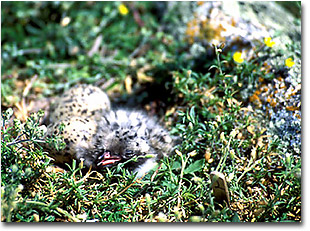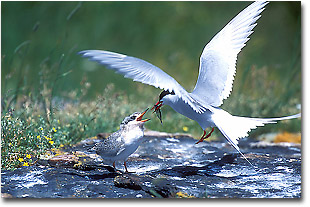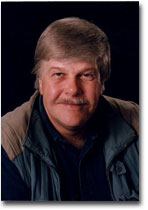|
|
 The Camera Hunter® The Professional Nature Photographer Photography and Text Copyright Bill Silliker, Jr. A recent NPN Forum topic came to mind as I prepared to write this month’s column: what is the difference between a professional and an amateur photographer. Here’s a sampling of Forum responses -
It Takes More Than Money
Don’t we have an image that a professional in any field is an “expert”-a person with a better than average capability derived from training and time spent doing something? Consider this excerpt of my response-
Am I wrong about that? Or should it only be about money? Before you answer, consider the following words about my visit to a Maine seabird nesting island a few weeks ago -
Plume hunters especially prized the terns. As a result, they decimated most of Maine’s nesting colonies of common and Arctic terns by the early 1900’s. Awareness of both the direct and indirect human impacts on seabirds has in recent years led to creative efforts to help them return to their historic nesting islands. And with each passing year, increasing numbers of seabirds return to the coast of Maine to raise their young.
After reading this, can you understand why it is a rare privilege to visit an Arctic tern nesting island to photograph them raising their young? There’s a message here for all who seek to photograph wildlife: none of us has a right to photograph any species. While most animals are readily available for all to photograph, some are at times so sensitive that we must either accompany researchers or have a special reason to access them. That’s not elitist. If all who sought to photograph terns landed on their nesting islands, the cumulative disturbance would disastrously impact their productivity. This trip was organized by a private citizen to help inform about the need for a Friends of Maine Seabird Islands. Why a new Friends group? As I write this, a critical $990,000 request from the annual distribution of the Land and Water Conservation Fund – money collected from offshore oil and gas leasing by the federal government, not taxes - has been removed from the Federal Fiscal Year 2003 budget. That means that 6 Maine islands that the USF&WS was to purchase from willing sellers to support similar seabird colonies face an uncertain future until acquisition funding is secured. Protecting these unique islands is the best hope we have of restoring a once magnificent resource for future generations to enjoy. Look again at the photograph of this world-traveling Arctic tern feeding its chick and tell me it’s not important work. The privilege to accompany the small group to land on Metinic Island recently was offered to this photographer because I have supported the efforts of the Petit Manan National Wildlife Refuge, which manages this special island, with my time, words and pictures - not because I am a so-called professional. Learn your craft, help with such efforts and you too might get such a lucky invitation someday. And you won’t have to be a classic definition “pro” – just be a “real” one. Catch yours in the good light. BS-NPN 012 Editor's Note - "Provia F, Bald Eagles and Brown Bears" a Fuji Pronet Tour to Katmai National Park led by "The Mooseman," Bill Silliker, Jr., in June 2002, was so successful that he'll be doing it again in 2003! For information on this special shoot, which will feature nesting bald eagles and coastal brown bears, query The Mooseman at mooseman@mainecoast.net. Comments on this column? Send them to the editor.
Bill has been an instructor of wildlife and nature photography with L. L. Bean's Outdoor Discovery Program since 1992 and is a member of the Fuji Film Talent Team. Bill is a past Board member of the North American Nature Photography Association (NANPA) and a professional member of the Outdoor Writer's Association of America (OWAA). He maintains a web site with tips for wildlife photographers at www.camerahunter.com and is editor of a site for all wildlife enthusiasts at www.wildlifewatcher.com. Bill's work with moose has been featured on National Public Radio's "Living On Earth", his book on bald eagles was featured on CSPAN's "Book TV" and his Daybreak 2000 image of the Millennium's dawn on NBC's "Today Show". To see the 2002 dates for Bill's slide talks for camera clubs sponsored by Fujifilm Professional, as well as a schedule of Bill's book signings and workshops with L.L. Bean, Great American Photography Weekend and The Maine Photographic Workshops, click here. |
|
|
 Those who felt that a professional is simply one who makes money from his or her photography are technically correct by the dictionary. But while the classic definition revolves around earning a living at a trade or craft, shouldn’t a “pro” also meet some standard for producing quality work in an ethical manner to deserve the broader meaning that so many of us attach to the designation?
Those who felt that a professional is simply one who makes money from his or her photography are technically correct by the dictionary. But while the classic definition revolves around earning a living at a trade or craft, shouldn’t a “pro” also meet some standard for producing quality work in an ethical manner to deserve the broader meaning that so many of us attach to the designation? Perhaps the most special of these birds is the Arctic tern. The Arctic terns leaving Maine’s islands in August fly across the Atlantic and then southward down the coast of Africa to the then summer waters of the Antarctic Ocean. That’s the longest migration known to man, a round trip of some 22,000 miles. But what’s more amazing is that these birds return year after year to not only the same island, but also to the same patch of open ground to nest!
Perhaps the most special of these birds is the Arctic tern. The Arctic terns leaving Maine’s islands in August fly across the Atlantic and then southward down the coast of Africa to the then summer waters of the Antarctic Ocean. That’s the longest migration known to man, a round trip of some 22,000 miles. But what’s more amazing is that these birds return year after year to not only the same island, but also to the same patch of open ground to nest! Maine wildlife & nature photographer Bill Silliker, Jr. - The Camera Hunter® - has photographed at many wild places in North America, with the results published in Audubon, Backpacker, Field & Stream; National Wildlife, Outdoor Photographer, Outdoor Life, Sports Afield and many other magazines; in exclusive calendar projects on loons, moose, wildlife and Maine's Baxter State Park, and in his books: Just Eagles; Uses For Mooses; Moose: Giants of the Northern Forest; Just Loons; and Maine Moose Watcher's Guide and his latest book, available in July 2002, Saving Maine:An Album of Conservation Success Stories.
Maine wildlife & nature photographer Bill Silliker, Jr. - The Camera Hunter® - has photographed at many wild places in North America, with the results published in Audubon, Backpacker, Field & Stream; National Wildlife, Outdoor Photographer, Outdoor Life, Sports Afield and many other magazines; in exclusive calendar projects on loons, moose, wildlife and Maine's Baxter State Park, and in his books: Just Eagles; Uses For Mooses; Moose: Giants of the Northern Forest; Just Loons; and Maine Moose Watcher's Guide and his latest book, available in July 2002, Saving Maine:An Album of Conservation Success Stories.